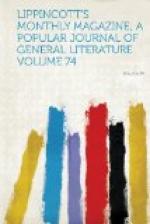Two torrents which fall in perpendicular cataracts from the mountains, the Kellunu ("yellow water”) and the Cca-chi ("salt"), run together at the distance of a league from their place of precipitation. They enclose in their approach the hill on which Marcapata is perched, and they form by their confluence the considerable river which our travelers were about to trace, and which is called by the Indians Cconi ("warm"), but on the Spanish maps is termed the river of Marcapata.
[Illustration: “The first ford of the Cconi was passed just outside the town.”]
The first ford of the Cconi was passed just outside the town, at a point where the right bank of the river, growing steeper and steeper, became impracticable, and necessitated a crossing to the left. The ford allowed the peons to stagger through at mid-leg on the uneven pavement afforded by the large pebbles of the bed. At this point the valley of the Cconi was seen stretching indefinitely outward toward the east, enclosed in two chains of conical peaks: their regular forms, running into each other at the middle of their height, clothed with interminable forests and bathed with light, melted regularly away into the perspective. Indian huts buried in gardens of the white lily which had seemed so beautiful in the chapel of Lauramarca, hedges of aloe menacing the intruder with their millions of steely-looking swords, slender bamboos daintily rocking themselves over the water, and enormous curtains of creepers hanging from the hillsides and waving to the wind in vast breadths of green, were the decorations of this Peruvian paradise.
The pretty lilies gradually disappeared, and the thatched cabins became more and more sparse, when from one of the latter, at a hundred paces from the caravan, issued a human figure. The man struck an attitude in the pathway of the travelers, his carbine on his shoulder, his fist on his hip and his nose saucily turned up in the air. Neither his Metamora-like posture nor his dress inspired confidence.
“He is evidently waiting for us,” remarked Colonel Perez, an heroic yet prudent personage: “fortunately, it is broad day. I would not grant an interview to such a salteador (brigand) alone at night and in a desert.”
The salteador wore a low broad felt, on whose ample brim the rain and sun had sketched a variety of vague designs. A gray sack buttoned to the throat and confined by a leathern belt, and trowsers of the same stuffed into his long coarse woolen stockings, completed his costume. He was shod, like an Indian, in ojotas, or sandals cut out of raw leather and laced to his legs with thongs. Two ox-horns hanging at his side contained his ammunition, and a light haversack was slung over his back. This mozo, who at a distance would have passed for a man of forty, appeared on examination to be under twenty-two years of age. It was likewise observable on a nearer view that his skin was brown and clear like a chestnut, and that his lively eye, perfect teeth and air of decision were calculated to please an Indian girl of his vicinity. To complete his rehabilitation in the eyes of the party, his introductory address was delivered with the grace of a Spanish cavalier.




